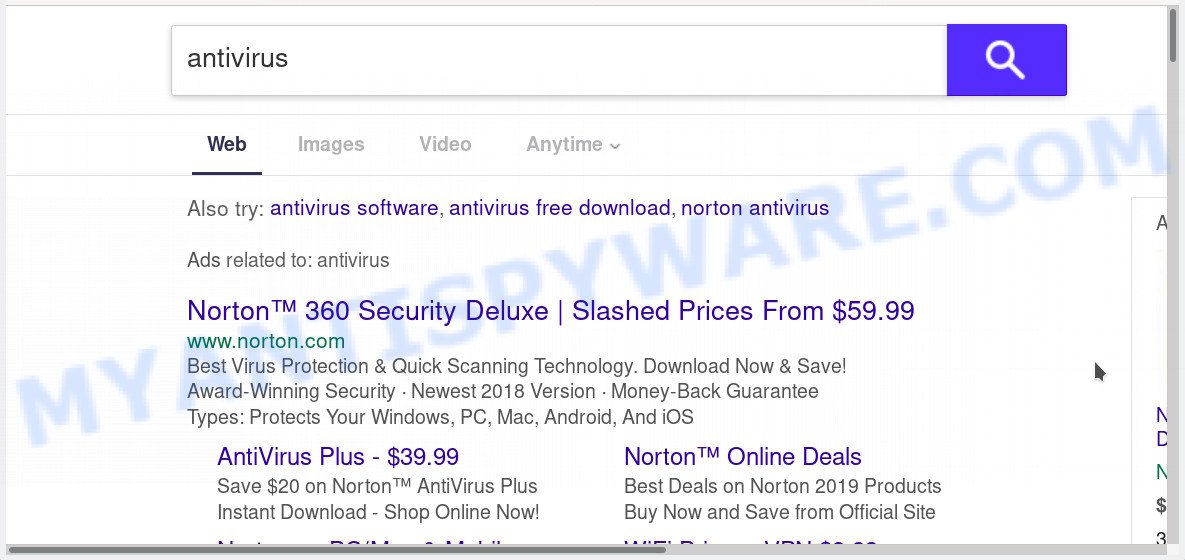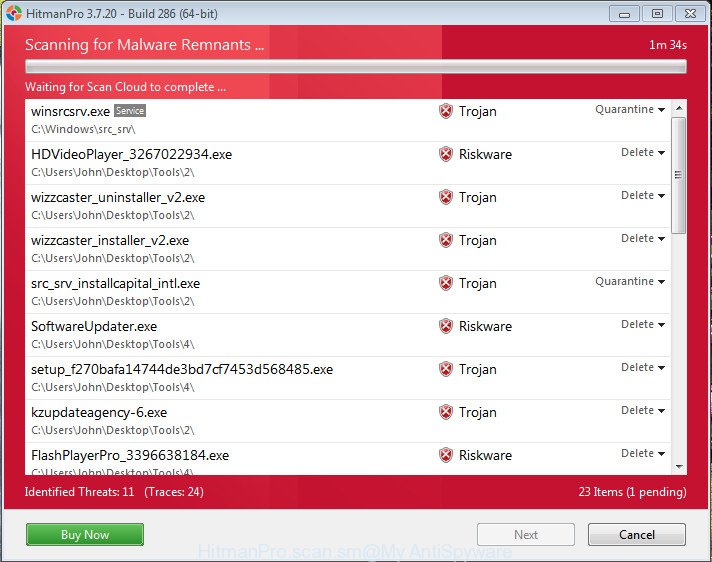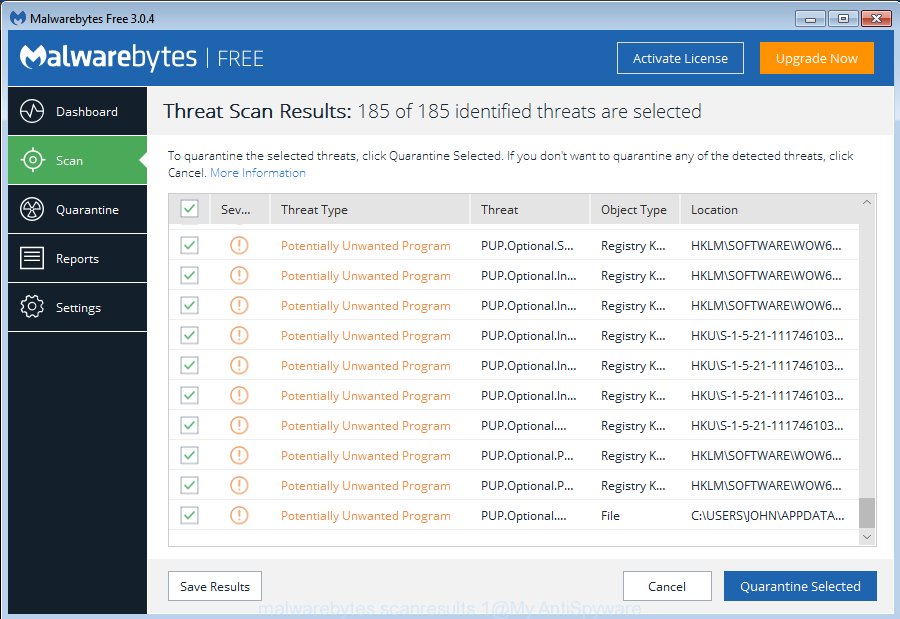Computer security professionals has determined that QuickMail is a potentially unwanted program which falls under the category of Browser hijackers. The so-called browser hijacker is created to manipulate your web-browser’s settings such as startpage, default search engine and newtab page, to modify your home page or search engine, so that the affected browser visits an unwanted website instead of your selected one. In the guide below, we will explain all the general information about the QuickMail browser hijacker and it’s typical behavior on the PC, as well as best possible methods to remove QuickMail from your Chrome, Firefox, Internet Explorer and Edge.

QuickMail makes unwanted changes to browser settings
The QuickMail hijacker will alter your internet browser’s search provider so that all searches are sent via QuickMail, which redirections to Bing, Yahoo or Google Custom Search engine that displays the search results for your query. The makers of this browser hijacker are utilizing legitimate search engine as they may earn money from the ads which are displayed in the search results.
While the QuickMail hijacker is active, you won’t be able to return the Firefox, Chrome, Microsoft Edge and Microsoft Internet Explorer’ settings like new tab page, home page and search provider by default. If you try to set your startpage to be Google, Bing or Yahoo, those settings will be automatically modified to QuickMail with the next system reboot. But this does not mean that you should just ignore it or get along with this fact. Because this is not the best option, due to the QuickMail you can have problems with the Edge, Google Chrome, Mozilla Firefox and IE, unwanted advertisements and even user information theft.
Threat Summary
| Name | QuickMail |
| Type | browser hijacker, search provider hijacker, homepage hijacker, toolbar, unwanted new tab, redirect virus |
| Symptoms |
|
| Removal | QuickMail removal guide |
Thus, it is clear that the presence of hijacker on your computer is not desirable, and you need to clean up your personal computer as soon as possible. Follow the few simple steps below in order to remove QuickMail from Chrome, Mozilla Firefox, IE and Microsoft Edge.
How to remove QuickMail from Chrome, Firefox, IE, Edge
When a browser hijacker such as the QuickMail gets installed on your computer without your knowledge, it is not easy to delete. In most cases, there is no Uninstall application which simply uninstall the browser hijacker infection responsible for redirects to QuickMail from your PC. So, we advise using several well-proven free specialized tools such as Zemana, MalwareBytes Free or HitmanPro. But the best way to remove QuickMail redirect will be to perform several manual steps, after that additionally use antimalware utilities.
To remove QuickMail, follow the steps below:
- Remove QuickMail redirect without any tools
- How to automatically remove QuickMail
- Use AdBlocker to stay safe online
- Why has my homepage and search engine changed to QuickMail?
- To sum up
Remove QuickMail redirect without any tools
Read this section to know how to manually remove the QuickMail hijacker. Even if the steps does not work for you, there are several free malicious software removers below which can easily handle such hijackers.
Delete potentially unwanted programs through the Microsoft Windows Control Panel
In order to get rid of QuickMail, first thing you need to do is to remove unknown and suspicious programs from your PC using MS Windows control panel. When removing this hijacker infection, check the list of installed applications and try to find dubious programs and remove them all. Pay special attention to newly installed programs, as it is most likely that the QuickMail hijacker сame along with it.
Windows 10, 8.1, 8
Click the Microsoft Windows logo, and then click Search ![]() . Type ‘Control panel’and press Enter as shown in the figure below.
. Type ‘Control panel’and press Enter as shown in the figure below.

Once the ‘Control Panel’ opens, click the ‘Uninstall a program’ link under Programs category as on the image below.

Windows 7, Vista, XP
Open Start menu and select the ‘Control Panel’ at right like below.

Then go to ‘Add/Remove Programs’ or ‘Uninstall a program’ (MS Windows 7 or Vista) as displayed in the figure below.

Carefully browse through the list of installed applications and get rid of all suspicious and unknown apps. We advise to click ‘Installed programs’ and even sorts all installed applications by date. When you have found anything dubious that may be the hijacker that causes web browsers to display undesired QuickMail web-site or other potentially unwanted application (PUA), then select this program and press ‘Uninstall’ in the upper part of the window. If the questionable program blocked from removal, then use Revo Uninstaller Freeware to fully remove it from your PC system.
Remove QuickMail from Chrome
Run the Reset web-browser utility of the Google Chrome to reset all its settings like start page, newtab and default search provider to original defaults. This is a very useful utility to use, in the case of browser hijacks like QuickMail.

- First, start the Chrome and click the Menu icon (icon in the form of three dots).
- It will display the Google Chrome main menu. Select More Tools, then click Extensions.
- You’ll see the list of installed extensions. If the list has the plugin labeled with “Installed by enterprise policy” or “Installed by your administrator”, then complete the following instructions: Remove Chrome extensions installed by enterprise policy.
- Now open the Google Chrome menu once again, click the “Settings” menu.
- Next, click “Advanced” link, which located at the bottom of the Settings page.
- On the bottom of the “Advanced settings” page, press the “Reset settings to their original defaults” button.
- The Chrome will show the reset settings dialog box as shown on the screen above.
- Confirm the web-browser’s reset by clicking on the “Reset” button.
- To learn more, read the post How to reset Google Chrome settings to default.
Remove QuickMail from Mozilla Firefox by resetting internet browser settings
This step will allow you get rid of QuickMail, third-party toolbars, disable harmful extensions and restore your default home page, newtab and search engine settings.
First, start the Mozilla Firefox and click ![]() button. It will display the drop-down menu on the right-part of the browser. Further, click the Help button (
button. It will display the drop-down menu on the right-part of the browser. Further, click the Help button (![]() ) like below.
) like below.

In the Help menu, select the “Troubleshooting Information” option. Another way to open the “Troubleshooting Information” screen – type “about:support” in the web browser adress bar and press Enter. It will show the “Troubleshooting Information” page as displayed on the image below. In the upper-right corner of this screen, press the “Refresh Firefox” button.

It will display the confirmation dialog box. Further, click the “Refresh Firefox” button. The Mozilla Firefox will start a process to fix your problems that caused by the QuickMail browser hijacker infection. After, it is done, click the “Finish” button.
Get rid of QuickMail homepage from Internet Explorer
If you find that Internet Explorer internet browser settings such as default search provider, newtab and home page had been hijacked, then you may revert back your settings, via the reset web browser process.
First, run the Microsoft Internet Explorer, then click ‘gear’ icon ![]() . It will display the Tools drop-down menu on the right part of the browser, then click the “Internet Options” like below.
. It will display the Tools drop-down menu on the right part of the browser, then click the “Internet Options” like below.

In the “Internet Options” screen, select the “Advanced” tab, then click the “Reset” button. The Internet Explorer will display the “Reset Internet Explorer settings” prompt. Further, press the “Delete personal settings” check box to select it. Next, click the “Reset” button as shown in the following example.

After the procedure is complete, click “Close” button. Close the IE and reboot your computer for the changes to take effect. This step will help you to restore your browser’s search provider, start page and new tab page to default state.
How to automatically remove QuickMail
Anti-Malware applications differ from each other by many features such as performance, scheduled scans, automatic updates, virus signature database, technical support, compatibility with other antivirus programs and so on. We recommend you use the following free apps: Zemana Anti-Malware (ZAM), MalwareBytes and HitmanPro. Each of these applications has all of needed features, but most importantly, they can identify the hijacker and get rid of QuickMail from the Microsoft Edge, Google Chrome, Mozilla Firefox and Internet Explorer.
Use Zemana to get rid of QuickMail hijacker
If you need a free utility that can easily scan for and get rid of browser hijacker that cause a reroute to QuickMail webpage, then use Zemana Anti Malware. This is a very handy program, which is primarily developed to quickly look for and remove adware software and malware infecting browsers and modifying their settings.

- Zemana AntiMalware can be downloaded from the following link. Save it to your Desktop so that you can access the file easily.
Zemana AntiMalware
164818 downloads
Author: Zemana Ltd
Category: Security tools
Update: July 16, 2019
- At the download page, click on the Download button. Your web-browser will display the “Save as” prompt. Please save it onto your Windows desktop.
- When the downloading process is complete, please close all software and open windows on your machine. Next, launch a file named Zemana.AntiMalware.Setup.
- This will run the “Setup wizard” of Zemana Anti-Malware onto your computer. Follow the prompts and do not make any changes to default settings.
- When the Setup wizard has finished installing, the Zemana Anti-Malware (ZAM) will launch and display the main window.
- Further, click the “Scan” button to detect browser hijacker which cause QuickMail webpage to appear. This procedure can take quite a while, so please be patient. When a malicious software, adware or PUPs are detected, the count of the security threats will change accordingly.
- When Zemana Free has finished scanning, a list of all items detected is prepared.
- Make sure to check mark the items that are unsafe and then press the “Next” button. The utility will remove hijacker infection responsible for redirects to QuickMail and move threats to the program’s quarantine. Once the clean up is done, you may be prompted to restart the PC system.
- Close the Zemana and continue with the next step.
Run Hitman Pro to remove QuickMail from the computer
HitmanPro is a portable tool which finds and removes undesired software like browser hijackers, adware, toolbars, other internet browser extensions and other malware. It scans your personal computer for hijacker which alters web-browser settings to replace your default search provider, new tab and startpage with QuickMail web-site and produces a list of threats marked for removal. HitmanPro will only erase those unwanted software that you wish to be removed.

- Installing the Hitman Pro is simple. First you’ll need to download Hitman Pro on your machine by clicking on the following link.
- When the downloading process is finished, launch the HitmanPro, double-click the HitmanPro.exe file.
- If the “User Account Control” prompts, press Yes to continue.
- In the HitmanPro window, press the “Next” to detect hijacker related to QuickMail . This procedure can take some time, so please be patient. While the Hitman Pro is checking, you may see how many objects it has identified either as being malware.
- After that process is finished, you will be shown the list of all detected threats on your computer. Make sure all threats have ‘checkmark’ and click “Next”. Now, click the “Activate free license” button to start the free 30 days trial to remove all malicious software found.
Get rid of QuickMail with MalwareBytes Anti Malware
We suggest using the MalwareBytes Free that are completely clean your PC system of the hijacker infection. The free utility is an advanced malicious software removal program made by (c) Malwarebytes lab. This program uses the world’s most popular anti-malware technology. It is able to help you remove browser hijacker, potentially unwanted programs, malicious software, adware, toolbars, ransomware and other security threats from your PC system for free.

Visit the page linked below to download the latest version of MalwareBytes Free for Windows. Save it on your Windows desktop.
327075 downloads
Author: Malwarebytes
Category: Security tools
Update: April 15, 2020
When downloading is complete, run it and follow the prompts. Once installed, the MalwareBytes Free will try to update itself and when this procedure is finished, click the “Scan Now” button to perform a system scan with this utility for the browser hijacker that responsible for internet browser reroute to the annoying QuickMail web page. A system scan may take anywhere from 5 to 30 minutes, depending on your computer. Make sure all items have ‘checkmark’ and click “Quarantine Selected” button.
The MalwareBytes Free is a free program that you can use to remove all detected folders, files, services, registry entries and so on. To learn more about this malware removal tool, we suggest you to read and follow the few simple steps or the video guide below.
Use AdBlocker to stay safe online
It is also critical to protect your browsers from malicious websites and advertisements by using an ad blocking program such as AdGuard. Security experts says that it will greatly reduce the risk of malware, and potentially save lots of money. Additionally, the AdGuard may also protect your privacy by blocking almost all trackers.
- AdGuard can be downloaded from the following link. Save it to your Desktop.
Adguard download
26848 downloads
Version: 6.4
Author: © Adguard
Category: Security tools
Update: November 15, 2018
- Once the downloading process is complete, start the downloaded file. You will see the “Setup Wizard” program window. Follow the prompts.
- After the installation is finished, press “Skip” to close the installation program and use the default settings, or click “Get Started” to see an quick tutorial which will allow you get to know AdGuard better.
- In most cases, the default settings are enough and you do not need to change anything. Each time, when you start your computer, AdGuard will start automatically and stop unwanted ads, block malicious or misleading web-pages. For an overview of all the features of the application, or to change its settings you can simply double-click on the icon named AdGuard, which can be found on your desktop.
Why has my homepage and search engine changed to QuickMail?
Usually, QuickMail hijacker gets into your PC system as part of a bundle with freeware, sharing files and other unsafe applications which you downloaded from the Web. The makers of this browser hijacker pays software authors for distributing QuickMail browser hijacker infection within their applications. So, optional programs is often included as part of the install package. In order to avoid the setup of any hijackers like QuickMail: select only Manual, Custom or Advanced installation type and disable all additional apps in which you are unsure.
To sum up
Now your personal computer should be free of the hijacker infection which designed to reroute your web browser to the QuickMail web-site. We suggest that you keep AdGuard (to help you stop unwanted advertisements and undesired harmful web-pages) and Zemana Anti Malware (ZAM) (to periodically scan your PC for new malicious software, hijackers and adware). Make sure that you have all the Critical Updates recommended for Microsoft Windows OS. Without regular updates you WILL NOT be protected when new hijacker infections, harmful software and adware are released.
If you are still having problems while trying to delete QuickMail from your internet browser, then ask for help here.


















